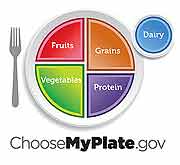Nutrition: Toddler
Helpful feeding information for your toddler
Feeding toddlers (ages 1 to 3) can often be challenging. That's because several developmental changes are happening at this time. Toddlers are striving for independence and control. Their growth rate slows down and with this comes a decrease in appetite. These changes can make mealtime difficult. It's important for parents to provide structure and set limits for the toddler. These suggestions can help manage mealtimes so that your toddler gets the nutrition they need:
Avoid battles over food and meals.
Provide regular meals and snacks.
Be flexible with food acceptance as toddlers are often reluctant to try new things. If your toddler refuses a food, don't make a big deal out of it. Try again in a few days or weeks.
Be realistic about food amounts. Portion size should be about one-fourth the size of an adult portion.
Limit juice intake. Encourage whole fruit instead.
Don't use dessert as a reward. Try serving it with the rest of the food.
Make the food easy for your toddler to eat:
Cut food into bite-size pieces.
Make some foods soft and moist.
Serve foods near room temperature.
Use ground meat instead of steak or chops.
Use a child-size spoon and fork with dull prongs.
Seat your child at a comfortable height in a secure chair.
Prevent choking by:
Slowly adding more difficult-to-chew foods.
Avoiding foods that are hard to chew and/or swallow, like nuts, raw carrots, gum drops, jelly beans, and peanut butter (by itself).
Modifying high-risk foods. Cut hot dogs in quarters, cut grapes in quarters, and cook carrots until soft.
Always supervising your child when they are eating.
Keeping your child seated while eating.

Healthy food choices
The MyPlate icon is a guideline to help you and your toddler eat a healthy diet. MyPlate focuses on eating a variety of foods while encouraging the right amount of calories and fat. The USDA and the U.S. Department of Health and Human Services have prepared the food plate to guide parents in selecting foods for children ages 2 and older.
The MyPlate icon is divided into five food group categories, emphasizing the nutritional intake of the following:
Grains. Foods that are made from wheat, rice, oats, cornmeal, barley, or another cereal grain are grain products. Examples include whole-wheat, brown rice, and oatmeal. Aim for mostly whole-grains.
Vegetables. Vary your vegetables. Choose a variety of colorful vegetables. Include dark green, red, and orange vegetables, legumes (peas and beans), and starchy vegetables.
Fruits. Any fruit or 100% fruit juice counts as part of the fruit group. Fruits may be fresh, canned, frozen, or dried, and may be whole, cut up, or pureed. The American Academy of Pediatrics recommends limiting juice to less than 4 ounces per day for children 1 to 3 years old.
Dairy. Milk products and many foods made from milk are considered part of this food group. Focus on fat-free or low-fat products, as well as those that are high in calcium.
Protein. Go lean on protein. Choose low-fat or lean meats and poultry. Vary your protein routine. Choose more fish, nuts, seeds, peas, and beans.
Oils are not a food group, yet some, like nut oils, contain essential nutrients and can be included in the diet. Limit animal fats.
Include exercise and everyday physical activity with a healthy dietary plan.
Nutrition and activity tips
Here are some tips to follow:
Try to control when and where food is eaten by your toddler by keeping regular daily meal times. Provide social interaction and model healthy eating behaviors.
Involve children in choosing and preparing foods and teach them to make healthy choices by helping them select foods based on their nutritional value.
Select foods with these nutrients when possible: calcium, magnesium, potassium, and fiber.
Most Americans need to reduce the number of calories they consume. When it comes to weight control, calories do count. Controlling portion sizes and eating nonprocessed foods helps limit calorie intake and increase nutrients.
Parents are encouraged to follow the recommended serving sizes for children.
Parents should try to limit children’s screen time to less than 1 to 2 hours daily. Instead, encourage activities that require more movement.
Children need at least 60 minutes of moderate to vigorous physical activity on most days for good health and fitness. This is also for healthy weight during growth.
To prevent dehydration, encourage children to drink fluid regularly during physical activity and drink several glasses of water or other fluid after the physical activity is completed.
To find more information about the Dietary Guidelines for Americans 2015–2020 and to determine the correct dietary recommendations for your child’s age, sex, and physical activity level, visit the Online Resources page for the links to the ChooseMyPlate.gov and 2015–2020 Dietary Guidelines sites. Please note that the MyPlate plan is designed for people older than age 2 who do not have chronic health conditions.
Always talk with your toddler’s healthcare provider regarding their healthy diet and exercise needs.
Connect with us:
Download our App: